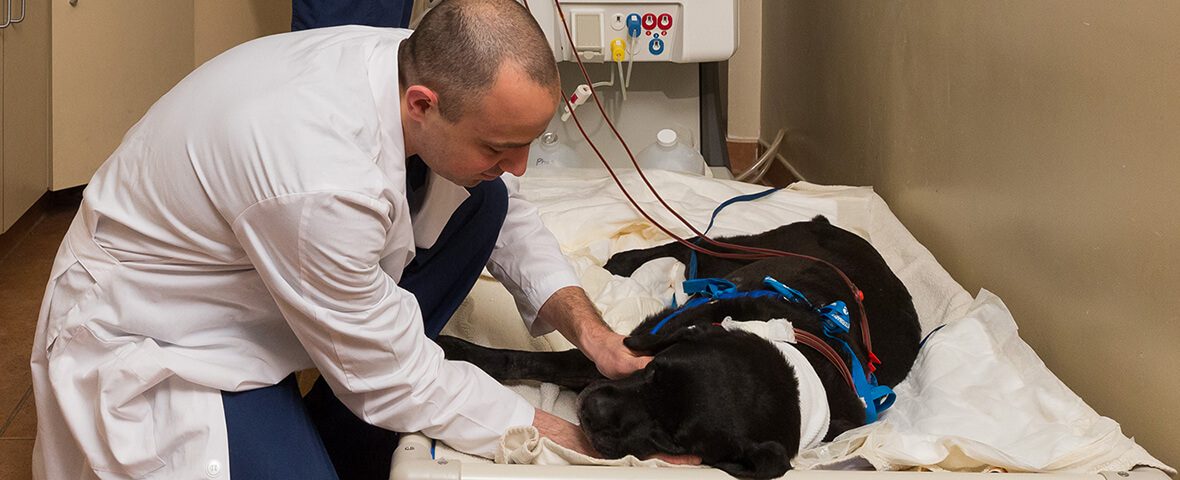Bladder cancer: Clinical signs, diagnosis and treatment.
Urinary system.
The urinary system consists of the kidneys, the ureters, the urinary bladder and the urethra. The kidneys are the organs that filter the blood to remove waste and maintain the electrolyte balance of the body. The filtered waste becomes urine, travels to the urinary bladder via the ureters, and continuously collects in the bladder.
The bladder is able to expand due to the special properties of its wall and inner lining. When an animal urinates, the urine is voided from the body through the urethra.
What is bladder cancer?
The most common type of urinary bladder cancer is transitional cell carcinoma (TCC). This is a tumor of the cells that line the inside of the urinary bladder. Other less common types of tumors of the bladder may include leiomyosarcomas, fibrosarcomas and other soft tissue tumors. TCC can also appear in the kidney, ureters, urethra, prostate or vagina. It can spread (metastasize) to the lungs, lymph nodes, bones or other organs.
Approximately 20% of dogs with bladder cancer have metastases at the time of diagnosis. Bladder cancer is much more common in dogs than cats, but TCC only accounts for less than 1% of all reported cancers in dogs. TCC can occur in any breed but is most common in Shetland sheepdogs, Scottish terriers, wirehair fox terriers, West Highland terriers, and beagles. Middle-aged or elderly female dogs are most commonly affected. Some studies have suggested that chronic exposure to certain chemicals (petrochemicals, pesticides) may increase the risk for a dog to develop bladder cancer.
Signs and symptoms of bladder cancer.
The signs of bladder cancer can be similar to those seen with urinary tract infections. These include small, frequent urination, painful urination, bloody urine and incontinence. Symptoms will often improve initially with the administration of antibiotics (as bladder infection is a common concurrent disease) but then recur a short time later.
A veterinarian may feel the tumor during abdominal palpation if it is large. If the tumor has spread to lymph nodes within the abdomen, they may be palpated during a digital rectal examination. The spread of tumors to bones can cause lameness or bone pain.
If the bladder tumor invades into the urethra, it can block urine flow and cause straining to urinate. If severe enough, this can eventually lead to kidney damage (hydronephrosis) and possibly kidney failure. Complete inability to urinate is a medical emergency and should be addressed by a veterinarian immediately.
Diagnosis.
- Urinalysis: Pets with bladder cancer sometimes have cancer cells found in their urine. Inflammation of the urinary tract from an infection can form similar-appearing cells, so this test is rarely diagnostic for bladder cancer. However, a urinalysis does check for secondary infections of the bladder (due to the tumor) and helps to evaluate the health of the kidneys.
- Blood work: Blood work is often normal in pets with bladder cancer unless kidney function is impaired. But blood work is important because it helps evaluate your pet’s overall health, which has an influence on treatment options.
- Veterinary bladder tumor antigen (VBTA) test: This is a screening test run on urine to check for bladder cancer in dogs. One of the pitfalls of this test is that dogs without bladder cancer might test positive for VBTA, especially if there is a bladder infection.
- Abdominal imaging: Bladder tumors are rarely evident on normal abdominal radiographs (X-rays), however spread of tumor to the bones may be evident. Sometimes special dye studies (cystograms) can be used to make the tumors visible on radiographs. This study is especially helpful if your veterinarian suspects that the tumor may be invading your pet’s urethra. Another way to image the abdomen is with ultrasound. Ultrasound is helpful for looking at the size of the tumor within the bladder and the size of lymph nodes adjacent to the urinary bladder.
- Chest imaging: Since bladder cancers can spread to the lungs, your veterinarian may take chest radiographs (X-rays) to check for metastases.
- Biopsy: To definitively diagnose TCC of the bladder, a sample of cancerous cells must be evaluated. This is usually done with either a surgical biopsy or from cells collected through an ultrasound-guided urinary catheter. In female dogs, cystoscopy (a camera is inserted into the bladder) is useful to directly visualize and biopsy the tumor. The biopsy will be sent to a pathologist to examine under a microscope.
Treatment.
- Surgery: Surgical removal of the entire tumor is rarely possible. This is because the tumor usually arises at the site where the ureters enter the bladder and the outflow region of the urethra. As a result, surgery would disrupt these vital structures. Occasionally the tumor arises elsewhere in the bladder (especially in cats), and surgery can remove all or most of the tumor.
When the tumor is only reduced in size at surgery this is called “debulking”. Although it may temporarily relieve symptoms for the pet, the tumor will regrow. - Chemotherapy: Unfortunately, a chemotherapy protocol that works well for bladder cancers in pets has not yet been found. Less than 20% of pets will respond to the intravenous chemotherapy protocols currently used. Certain oral nonsteroidal anti-inflammatory drugs, such as piroxicam (Feldene®) or meloxicam (Metacam®), have demonstrated anti-cancer activity with TCC and may help some dogs. These work best when combined with chemotherapy.
- Radiation therapy: Radiation therapy can be helpful in some patients with bladder cancer. Although some studies suggest it works better than chemotherapy, it can have serious side effects.
Prognosis.
The long-term prognosis for pets with bladder cancer is generally poor, regardless of treatment. However, with treatment, pets can have an improved quality of life for a period of time. On average, dogs with TCC of the bladder live 4-6 months without treatment, and 6-12 months with treatment.
For more information on this subject, please talk to the veterinarian treating your pet.


